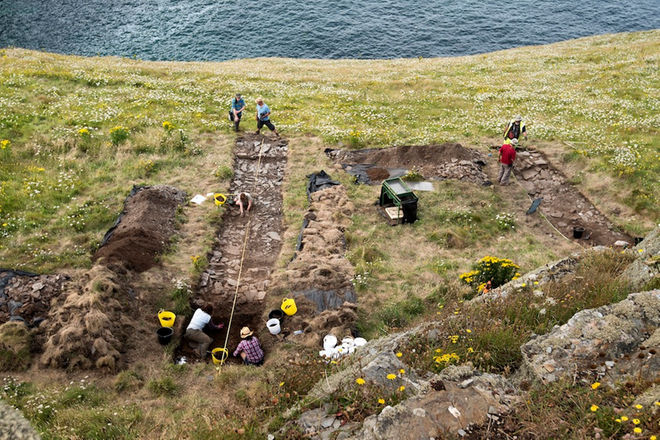Just off the coast of Cornwall, England lies the birthplace of King Arthur. Archaeologists have been investigating the are of Tintagel and have uncovered a wide variety of high end artifacts.

Photo: Live Science
During their excavation of King Arthurs birthplace, archaeologists have found a number of “high-status” items such as pottery and glass. Experts believe that this area was most likely occupied during the 5th to the 7th century. They also believe that the area was occupied by the kings of Dumnonia, which was a native kingdom during the Medieval time period.
Win Scutt, works for English Heritage as a curator, has said that over 200 rare items were found during this excavation. The pottery and glass is believed to have been imported from the Mediterranean. These items suggest that the settlement was actually part of a trade route that went through the Mediterranean region during the time period.
Among the items that were found, many shards of a red-glazed pottery were uncovered. This red pottery is also known as “Phocaean red-slip ware,” which originates from Turkey. Archaeologists have also recovered storage jars that would have held wine or olive oil. Although these storage jars and glass shards have been found in other United Kingdom sites.
What About King Arthur?
As legend has it, King Arthur was born in Tintagel. King Arthur was the British King who is believed to have stood up to the Saxons towards the end of Roman rule. As the story goes, King Arthur’s mother was seduced by a man named Uther Pendragon who was disguised as her husband.
There is no historical evidence that proves King Arthur’s existence. However, in 1998, an inscription upon a stone saying “Artognou” was uncovered in Tintagel. This discovery sparked a ton of speculation about the legend of King Arthur. Some believe that this name might actually be referring to the famous king. Despite this common belief, Scutt and many other archaeologists believe that this specific stone refers to someone else, not King Arthur.
The Excavation
This recent excavation is the first in a series of excavations to take place over the next five years. The main goal of this particular excavation is to establish the significance of this site by confirming its dates. Experts also want to determine the meaning of the 100 structures that have been placed all around Tintagel. Scutt comments that, “These are the first really good scientific excavations of undisturbed ground. We’ve really gone for areas that have deep stratigraphy where we can see good separation.”
One thing that archaeologists have come to a consensus on is, the structures in Tintagel may have been a royal structure for the Kingdom of Dumnonia. However, there is no clear evidence that proves this theory to be true. Some experts have even brought up the theory that these structures are actually the remains of a castle that was built during the 13th century.
Most experts working on this project believe that these structures date back to the 5th and 7th centuries. Scutt comments that, “There are lots of other possibilities – it could be a mercantile site, based perhaps on the export of Cornish minerals, such as tin, lead, and silver. We can say it is high-status and that rich people lived there, but that doesn’t necessarily equate to political power – it could be purely a mercantile center.”

